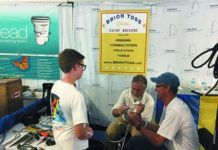We recently receivied an e-mail from Bill Boyeson, a reader in Seattle, WA. Boyeson wanted to share his experience with Tacktick’s electronic RaceMaster compass. He felt that we should “warn” readers because “even though these are wonderful products, they have a fairly short life-about five years in my case.”
Granted, many electronic devices do have relatively short lifespans compared to their mechanical counterparts, but Boyeson’s problem-as assessed by a Tacktick representative-was a dead battery. What’s the rub? The battery in these units is classified by the company as “unserviceable.” That’s because the RaceMaster, like all Tacktick’s products, is a sealed-for-life unit, and that’s done to ensure that it remains waterproof. The only option he had, said the rep, was to purchase a new unit. Though Boyeson was offered a 20% discount on that new compass, this wasn’t the resolution he had in mind.
“Anyone who spends nearly $1,000 for a piece of equipment should be warned that it very likely will be a paperweight in five years,” he said. “In our current world of disposable everything, Ive come to accept the $99 “throwaway” camera, or disposable VCR, but when I spend $1,000 and it’s still throwaway, I start to question the sanity of my purchase.”
According to Clive Johnson at Tacktick’s home office in the UK, all Tacktick’s products have a two-year warranty, and the company prorates warranty work after that for three additional years. So what’s a reasonable lifespan for a product like this, we asked Johnson?
He didn’t want to stipulate any amount of time in answering that, but told us: “…the life of a product is totally dependent on the type of use, customer care, etc., as is the case with all consumable items-cars, phones, computers, etc. However, we have been producing instruments for nine years now and we develop them for the harshest of marine electronic use, i.e. Olympic competitors that sail year-round, turn boats upside-down, expect only the best from their equipment, and treat it often with little respect.”
Both viewpoints are valid. Like Boyeson, we think Tacktick could engineer a replaceable battery for its compass and still manufacture a waterproof unit. That would be the ideal solution, but the product is nonetheless functional, and its performance impressive. And without more customers like Boyeson clamoring for change, Tacktick has little incentive to alter the status quo.
Fortunately, the status quo is under strong attack in other realms. Chuck Hawley, West Marine’s vice president of product development told us that the company has recently been redoubling its quality control efforts. After recent in-house tests of waterproof VHFs showed a 33% failure rate, Hawley said West took the following steps: 1. notified all buyers of VHF radios that these products may not be waterproof; 2. changed signs in the stores to de-emphasize waterproofness; 3. inserted notices in the remaining radios to alert customers to the company’s test findings; 4. changed information on the company’s website to indicate that these radios might fail; 5. offered free waterproof bags to any customer requesting one; 6. stopped buying radios from a particular supplier even after that company made some improvements; 7. shared the test results with all their VHF vendors; 8. instituted a quality management department; and 9., established a new on-line address so customers can share feedback (www.gearfeedback@westmarine.com).
PS commends these initiatives. We intend to keep a close eye on West Marine’s testing in the coming months. Is it an ideal solution? Maybe not, but it’s a definitely a strong start.
-Dan Dickison



































